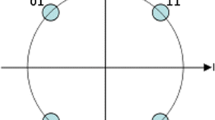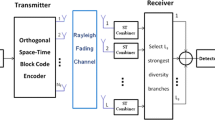Abstract
In this letter, we propose an improved Quasi-orthogonal space-time block code (QOSTBC) with full rate, full diversity, linear decoding and better peak-to-average power ratio (PAPR). Constellation rotation is used to the input symbol vector to ensure full diversity, and then the information symbol vector is interleaved in coordinates and pre-grouped by using a Given rotation matrix. The performance is evaluated by numerical experiments. The PAPR of our proposed QOSTBC is lower than that of CI-QOSTBC in Khan and Rajan (IEEE Trans Inf Theory 52(5):2062–2091, 2006). Meanwhile, the Bit-error-rate versus Signal-to-noise-ratio of our proposed QOSTBC is better than those of OSTBC (Tarokh et al. in IEEE Trans Inf Theory 45(5):1456–1467, 1999) QOSTBC (Jafarkhani in IEEE Trans Wirel Commun 49(1):1–4, 2001), G-QOSTBC (Park et al. in IEEE Commun Lett 12(12):868–870, 2008), slightly better that of the CI-QOSTBC, and as same as that of the recently proposed Minimum Decoding Complexity QOSTBCs (MDC-QOSTBC) in Yuen et al.(IEEE Trans Wirel Commun 4(5):2089–2098, 2005), Wang and Xia (IEEE Trans Inf Theory 55(3):1104–1130, 2009). Compared with MDC-QOSTBC, the proposed QOSTBC has simpler code construct and lower decoding complexity.
Similar content being viewed by others
References
Alamouti S. M. (1998) A simple transmitter diversity scheme for wireless communications. IEEE Journal on Selected Areas in Communication 16(8): 1451–1458
Tarokh V., Seshadri N., Calderbank A. R. (1998) Space-time codes for high data rate wireless communication: performance criterion and code construction. IEEE Transactions on Information Theory 44(2): 744–765
Tarokh V., Jafarkhani H., Calderbank A. R. (1999) Space-time block codes from orthogonal designs. IEEE Transactions on Information Theory 45(5): 1456–1467
Jafarkhani H. (2001) A quasi-orthogonal space-time block code. IEEE Transactions on Wireless Communications 49(1): 1–4
Park U., Kim S., Lim K., Li J. (2008) A novel QOSTBC scheme with linear decoding for three and four transmit antennas. IEEE Communications letters 12(12): 868–870
Khan M., Rajan B. S. (2006) Single-symbol maximum likelihood decodable linear STBCs. IEEE Transactions on Information Theory 52(5): 2062–2091
Yuen C., Guan Y., Tjhung T. T. (2005) Quasi-orthogonal STBC with minimum decoding complexity. IEEE Transactions on Wireless Communications 4(5): 2089–2094
Wang D., Xia X. G. (2009) On optimal quasi-orthogonal space-time block code with minimum decoding complexity. IEEE Transactions on Information Theory 55(3): 1104–1130
Dayal P., Varanasi M. K. (2005) Maximal diversity algebraic space-time codes with low peak-to-mean power ratio. IEEE Transactions on Information Theory 51(5): 1691–1708
Author information
Authors and Affiliations
Corresponding author
Rights and permissions
About this article
Cite this article
Pham, VB., Qi, BY., Sheng, WX. et al. An Improved Full Rate Full Diversity QOSTBC with Linear Decoding in MIMO Systems. Wireless Pers Commun 69, 121–131 (2013). https://doi.org/10.1007/s11277-012-0564-z
Published:
Issue Date:
DOI: https://doi.org/10.1007/s11277-012-0564-z




